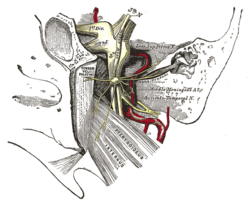Otic ganglion
| Nerve: Otic ganglion | |
|---|---|
 | |
| The otic ganglion and its branches. | |
 | |
| Mandibular division of trifacial nerve, seen from the middle line. The small figure is an enlarged view of the otic ganglion. | |
| Latin | ganglion oticum |
| Gray's | p.897 |
| Innervates | parotid gland |
| From | lesser petrosal nerve |
The otic ganglion is a small, oval shaped, flattened parasympathetic ganglion of a reddish-gray color, located immediately below the foramen ovale in the infratemporal fossa. It gives innervation to the parotid gland for salivation.
It is one of four parasympathetic ganglia of the head and neck. (The others are the submandibular ganglion, pterygopalatine ganglion, and ciliary ganglion).
It is occasionally absent.[1]
Filaments
Filaments that pass through the ganglion without synapsing:
- Nerve to tensor tympani
- Nerve to tensor veli palatini
Both are innervated by the medial pterygoid nerve from Trigeminus V3 (mandibular nerve)
Branches of communication
Its sympathetic postganglionic fibers consists of a filament from the plexus surrounding the middle meningeal artery.
Preganglionic parasympathetic fibers originate from the glossopharyngeal nerve via the lesser petrosal nerve. The lesser petrosal nerve is a continuation of the glossopharyngeal nerve after it exits the skull via the jugular foramen and innervates the tympanic plexus. Postganglionic parasympathetic fibers travel with the sympathetic fibers of the auriculotemporal nerve (a branch of CN V3) to supply the parotid gland. All postsynaptic parasympathetics will use some branch of the Trigeminal Nerve to get from one of four parasympatheic ganglia (Otic, Ciliary, Submandibular, and Pteryopalatine) to their destinations in either smooth muscle or glandular tissue (secretomotor).
A slender filament (sphenoidal) ascends to the nerve of the Pterygoid canal, and a small branch connects with the chorda tympani.
It is connected by two or three short filaments with the nerve to the Pterygoideus internus, from which it may obtain a motor, and possibly a sensory root.

Distribution
Its branches of distribution are: a filament (V3 to Medial Pterygoid mm) to the Tensor tympani, and one to the Tensor veli palatini.
The former passes backward, lateral to the auditory tube; the latter arises from the ganglion, near the origin of the nerve to the Pterygoideus internus, and is directed forward.
The fibers of these nerves are, however, mainly derived from the nerve to the Pterygoideus internus.
Clinical Correlations
Frey's syndrome in which salivation will induce perspiration at the parotid region, accompanied by erythema.
Additional images
-

Plan of the facial and intermediate nerves and their communication with other nerves.
-

Diagram of efferent sympathetic nervous system.
-

Dissection of otic ganglion
-
Otic ganglion
References
- ↑ Roitman R, Talmi YP, Finkelstein Y, Sadov R, Zohar Y (1990). "Anatomic study of the otic ganglion in humans". Head Neck 12 (6): 503–6. doi:10.1002/hed.2880120610. PMID 2258290.
- Shimizu T (1994). "Distribution and pathway of the cerebrovascular nerve fibers from the otic ganglion in the rat: anterograde tracing study". J. Auton. Nerv. Syst. 49 (1): 47–54. doi:10.1016/0165-1838(94)90019-1. PMID 7525688.
External links
- cranialnerves at The Anatomy Lesson by Wesley Norman (Georgetown University) (V, IX)
- Otic+ganglion at eMedicine Dictionary
This article incorporates text from a public domain edition of Gray's Anatomy.
| |||||||||||||||||||||||||||||||||||||||||||||||||||||||||||||||||||||||||||||
| |||||||||||||||||||||||||||||||||||||||||||||||||
| |||||||||||||||||||||||||||||||||||||||||||||
